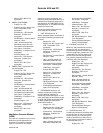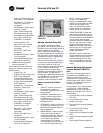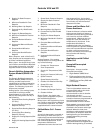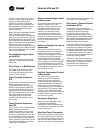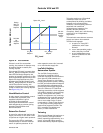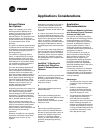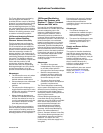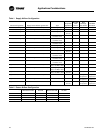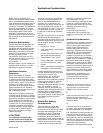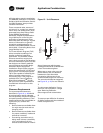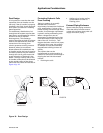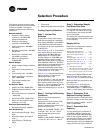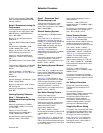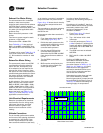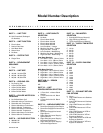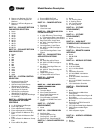
RT-PRC031-EN 25
Applications Considerations
When using an IntelliPak II Air
Handler for horizontal supply and/or
return, an additional pressure drop
must be added to the supply external
static to account for the 90 degree
turn the air is making. This additional
pressure drop depends on airflow
and air handler size, but a range of
0.10 inches to 0.30 inches can be
expected. The openings on the air
handler all have a one inch lip around
the perimeter to facilitate ductwork
attachment.
Corrosive Atmospheres
Trane's IntelliPak II Air Handlers are
designed and built to industrial
standards and will perform to those
standards for an extended period
depending on the hours of use, the
quality of maintenance performed,
and the regularity of that
maintenance. One factor that can
have an adverse effect on unit life is
its operation in a corrosive
environment.
Because copper is more resistant to
corrosion than aluminum, coil life
expectancy is greatly increased.
Ventilation Override
Sequences
One of the benefits of using an
exhaust fan rather than a return fan,
in addition to the benefits of lower
energy usage and improved building
pressurization control, is that the air
handler can be used as part of a
ventilation override system. Several
types of sequences can be easily
done when exhaust fans are a part of
the air handling system.
What would initiate the ventilation
override control sequence? Typically,
a manual switch is used and located
near the fire protection control panel.
This enables the fire department
access to the control for use during
or after a fire. It is also possible to
initiate the sequence from a field-
installed automatic smoke detector.
In either case, a contact closure
begins the ventilation override
control sequence.
ƽCAUTION!
The ventilation override system
should not be used to signal the
presence of smoke caused by a fire.
Trane can provide five (5) different
ventilation override sequences on
both CV and VAV IntelliPak II Air
Handlers. For convenience, the
sequences are factory preset but are
fully field edited from the Human
Interface Panel or Tracer™. Any or all
five sequences may be “locked” in
by the user at the Human Interface
Panel.
The user can customize up to five (5)
different override sequences for
purposes such as smoke control. The
following parameters within the unit
can be defined for each of the five
sequences:
• Supply Fan - on/off
• Inlet Guide Vanes - open/closed/
controlling
• Variable Frequency Drives - on
(60 Hz)/off (0 Hz)/controlling
• Exhaust/Return Fan - on/off
• Exhaust Dampers - open/closed
• Economizer dampers - open/
closed
• Heat - off/controlling (output for)
VAV Boxes - open/controlling
Factory preset sequences include
unit Off, Exhaust, Purge, Purge with
duct pressure control, and
Pressurization. Any of the user-
defined Ventilation Override
sequences can be initiated by closing
a field supplied switch or contacts
connected to an input on the
Ventilation Override Module. If more
than one ventilation override
sequence is being requested, the
sequence with the highest priority is
initiated. Refer to the Ventilation
Override Module (VOM) page 17 in
the Control section of this catalog for
more details on each override
sequence.
Natural Gas Heating
Considerations
Trane uses heavy gauge 304 L
stainless steel throughout the
construction of its natural gas drum
and tube heat exchangers for the
IntelliPak II product. These heat
exchangers can be applied with
confidence, particularly with full
modulation control, when mixed air
temperatures are below 50°F, and low
ambient temperatures can cause
condensation to form on the heat
exchanger. IntelliPak II natural gas
heat exchangers are not
recommended for applications with
mixed air conditions entering the
heat exchanger below 30°F to insure
adequate leaving air heating
temperature.
For airflow limitations and
temperature rise across the heat
exchanger information, see Table 27,
p. 70.
Acoustical Considerations
The ideal time to make provisions to
reduce sound transmission to the
space is during the project design
phase. Proper placement of air
handler equipment is critical to
reducing transmitted sound levels to
the building. The most economical
means of avoiding an acoustical
problem is to place any air handler
equipment away from acoustically
critical areas. If possible, air handling
equipment should not be located
directly above areas such as: offices,
conference rooms, executive office
areas and classrooms. Ideal locations
are above corridors, utility rooms,
toilet facilities, or other areas where
higher sound levels are acceptable.
Several basic guidelines for unit
placement should be followed to
minimize sound transmission
through the building structure:
1
Locate the unit's center of gravity
close to or over a column or main
support beam to minimize roof
deflection and vibratory noise.
2
If the roof structure is very light, roof
joists should be replaced by a
structural shape in the critical areas
described above.
3
If several units are to be placed on
one span, they should be staggered
to reduce deflection over that span.
It is impossible to totally quantify the
effect of building structure on sound
transmission, since this depends on
the response of the roof and building
members to the sound and vibration
of the unit components. However, the
guidelines listed above are
experience proven guidelines which



